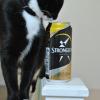It occurred to me the other day that although there was a few previous threads giving some coverage to the subject, there was no 'one stop shop' for information on oversills.
Oversills, or 'cover sills' are a sadly regular bodywork phenomenon. I have in fact never managed to buy a mini that didn't have them, most people fit them for the sake of 12 months MOT, some fit them in error and a few people fit them thinking the problem is water getting into the sills, whereas in fact the sills are vented for the purpose of moisture being able to exit the sill.
Oversills block the venting, and thus moisture builds up and rots the structural parts of your car from the inside out. I bought a project car recently and it came with oversills. I'd already fitted proper narrow heritage sills onto a different Mini so i used this opportunity to demonstrate to other mini owners what the difference is. This is a shell turned on its side, with the correct vented narrow sill fitted:

This is a photo of an oversill panel courtesy of W&P. As you can see, its wider and pressed to take into account the original vents and weld line. The name 'over sill' coming from its role of going over the original sills!
 Classic-Mini-Magnum-Panel-Lh-Outer-Extended-1015754026.jpg 29.58K
2 downloads
Classic-Mini-Magnum-Panel-Lh-Outer-Extended-1015754026.jpg 29.58K
2 downloads
And this is how things look when you remove them again (same car as first picture...!)

I just wanted to put this pictorial together to educate people out there as buyers and budding bodyworkers because oversills either mean the car has, or will have, hidden horrors. A quick repair it may be but down the line it will significantly damage the structure of a car, as well as its value, especially when you have to sell it needing all the welding ive just had to carry out.
I hope this helps any future buyers or restorers and if it stops at least one car from the peril of sill bodges then I've succeeded! Feel free to share and ask any questions if you should so desire.
Edited: Replaced out of date photo's.
Edited by Down&Out, 11 June 2024 - 08:11 PM.





























